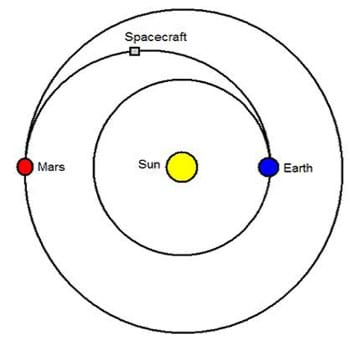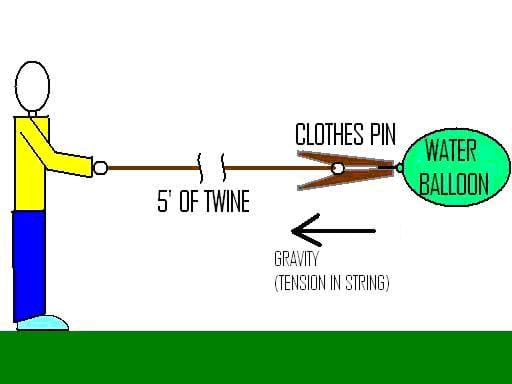The Great Gravity Escape
Activity courtesy of TeachEngineering.org
Grade level: 6-8
Time: 45 minutes
Cost per group: $1
Summary
Engineering Connection
Learning Objectives
After this activity, students should be able to:
- Understand that an orbit is the balancing of object’s velocity with the gravitational force.
- Realize that as the velocity of an orbiting object increases, gravity has a harder time keeping the object close.
- Understand that engineers must design and build huge rockets to escape the Earth’s gravity.
- Understand that gravity is still acting on an object that is in orbit even though it is a weightless environment.
Educational Standards
Next Generation Science Standards
- Develop and use a model to describe the role of gravity in the motions within galaxies and the solar system.
- Construct and present arguments using evidence to support the claim that gravitational interactions are attractive and depend on the masses of interacting objects.
Common Core State Standards – Mathematics
- Fluently divide multi-digit numbers using the standard algorithm. [Grade 6]
- Fluently add, subtract, multiply, and divide multi-digit decimals using the standard algorithm for each operation. [Grade 6]
International Technology and Engineering Educators Association
- Knowledge gained from other fields of study has a direct effect on the development of technological products and systems. [Grades 6 – 8]
Materials
Each group needs:
- 1 water balloon
- 5 ft (1.5 m) length of twine or string
- 1 clothes pin (the type with metal springs)
- 1 stop watch
- Orbiting Water Balloons Worksheet [PDF]
Introduction/Motivation

In today’s activity, we will use water balloons to demonstrate how an orbit is the balance between gravity and the velocity of the spacecraft. We will see that once an object is traveling fast enough, the orbiting object can “escape” from the gravitational pull of the planet.
Procedure
Before the Activity
- Cut one 5-foot length of twine for each group.
- Thread one end of the twine through the metal spring on the clothes pin and tie a double knot in it so that the clothes pin hangs from the end of the twine.
- Fill water balloons with ~100 grams of water, making the balloons about 2 inches in diameter. Fill two balloons, or more, per group (one for the activity and one for a spare). Temporarily store balloons in a plastic bucket.
- Make enough copies of the Orbiting Water Balloons Worksheet, one per group.
- Find a place outside where teams have at least 20 feet (6 m) clear in all directions around them. The more space provided, the safer the activity. (Note: A football/practice field or large lawn area works well.)
With the Students
- Tell the students that today they will use water balloons to learn about orbits.
- Explain to them that they will each represent a planet, and a water balloon — connected to a string that they will use to swing the balloon around them — represents an orbit.
Remind them that they learned that an object that is moving wants to travel in a straight line. For an object to turn, a force must act on it. The Earth’s gravitational force is the acting force that turns the object, creating the elliptical (curved) path of an orbiting object. To change the path of their water balloons, they must apply force to the balloons. In this case, the tension in the string represents the gravity that keeps an object in orbit. See Figure 2 for a drawing of the experiment set-up.

- Hold up one length of twine that already has the clothes pin attached. Demonstrate how to carefully clip the balloon onto the clothespin.
- Ask the students: What will happen if you begin spinning the balloon around yourself — faster and faster? (Answer: The clothes pin will eventually let go of the balloon.) Why does this happens? (Answer: As the balloon spins faster the clothes pin cannot apply the force necessary to keep the balloon in orbit and it lets go. Once this happens, the balloon travels in a straight line, according to Newton’s first law of motion.)
- Pass out to each group a worksheet, stop watch and string with clothes pin attached.
- Move students outside to a pre-selected space with adequate room for them to spread out and do the activity.
- Now give groups each one water-filled balloon and tell them to securely attach the ends of the balloons to their clothes pins.
- Have one group member stand in the middle of a designated open area while the remainder of the group stands back at least 20 feet.
- Have the students with the strings and balloons start swinging the balloons slowly around their bodies so they are moving just fast enough to keep the balloons a few feet above the ground.
- Have another student use the stop watch to time 10 seconds. While this person is timing, have the remaining students count how many times the balloon goes around in those 10 seconds. Record this number on the worksheets.
- Have the students who are swinging the balloons speed up their balloons slightly.
- Have the other students repeat counting the number of rotations in 10 seconds intervals.
- Repeat steps 10 and 11 until the balloons come off the clothes pin.
- Now have the students rotate roles, so that every student has a chance to be a planet with a balloon in orbit.
- Once all teams have finished, have them come back inside and calculate the escape velocities, using the worksheets.
- Conclude with a class discussion to compare calculations and results. Conduct the post-activity assessment activity described in the Assessment section.
Assessment
Pre-Activity Assessment
Discussion Question: Solicit, integrate and summarize student responses.
- Sketch a planet (a circle) with a “spacecraft launcher” on top of it (a stick figure with a tube). Ask students to sketch the path the spacecraft travels if it is: a) thrown from the tower like a glider; b) launched into the sky like a plane, but runs out of fuel near where planes fly ~7 miles up; c) launched with enough velocity to enter orbit around the Earth and fly near the International Space Station; or d) launched with enough velocity that it escapes an orbit around Earth and lands on Mars. [Answers: a) The spacecraft falls to the ground; b) The spacecraft makes an arc, but crashes (or lands) back on Earth; c) The spacecraft enters orbit around the Earth, and d) The spacecraft escapes an orbit around Earth, but still orbits around the Sun (remember that all things that have mass have gravity between them).]
- Is there gravity in space? (Answer: Since space is a weightless environment, it seems like there is no gravity, but there actually is gravity in space! When a spaceship is in orbit, gravity and the velocity of the spaceship are exactly balanced.)
Activity Embedded Assessment
Worksheet: Have student teams use the attached Orbiting Water Balloon Worksheet for instructions, recording measurements and making calculations. Review their answers to gauge their mastery of the subject.
Post-Activity Assessment
Numbered Heads: Divide the class into teams of three to five students each. Have students on each team number off so each has a different number. Ask the students a question and give them a short time frame for solving it (~1 minute). Have team members work together on the answer and make sure everyone on the team knows it. Call a number at random. Students with that number should raise their hands to answer the question. If not all students with that number raise their hands, give the teams time to work a little longer. Example questions:
- What is the force that pulls objects towards the center of the Earth? (Answer: Gravity)
- Which of Newton’s laws tells us that an object in motion tends to stay in motion and that the only way for an object to slow down, speed up, or turn is if a force acts on the object? (Answer: Newton’s first law of motion.)
- True or False: There is no gravity in space. (Answer: False)
- What happens as the spacecraft speeds up? (Answer: The spacecraft eventually overpowers the gravitational pull of the Earth and leaves the Earth’s orbit.)
- An orbit is the balance between the velocity of the object and what force? (Answer: The planet’s gravitational force.)
- As velocity decreases, the object gets closer/further from Earth? (Answer: Closer)
Safety Issues
- Make sure students stand a sufficient distance away from the swinging water balloons and that they pay attention to the other students as they perform the experiment.
- To keep from getting dizzy, have students use lasso motions over their heads to swing their balloons, instead of turning their entire bodies.
Troubleshooting Tips
- Make sure the balloons are well secured by the clothes pins. This ensures that the balloons do not come off the strings too early. If students cannot handle water balloons, find another object that is soft, but also weighs around 100 grams, such as a wiffle- or sponge-type ball.
- Keep one important detail in mind when comparing the string to the force of gravity on a spacecraft. In space, the distance from the planet (diameter of orbit) would get larger as a spacecraft speeds up. (Ask the class: Does the string get longer as you spin faster? Answer: No!) In this activity, the string does not get longer as a water balloon is spun faster. The orbital escape velocity of the spacecraft, the velocity at which the gravity between the objects can no longer hold them together, is achieved when the clothespin releases and the balloon flies off.
Activity Extensions
Have students weigh different balloons and see if they can find a relationship between the mass of the balloon and the escape velocity. The students should see that a heavier balloon releases at a lower velocity. (Note: To see this result, the mass of the larger balloon must be significantly heavier — at least 50%.)
References
Wertz, James R. and Larson, Wiley J. Space Mission Analysis and Design, Third Edition, Space Technology Library, Volume 8, New York, NY: Publishing Company, 1999.
Additional Resources
What is Gravity? Short primer with animated gifs from NASA’s Space Place.
Contributors
Geoffrey Hill; Daria Kotys-Schwartz; Chris Yakacki; Malinda Schaefer Zarske; Timothy M. Dittrich; Janet Yowell
Copyright
© 2004 by Regents of the University of Colorado.
Supporting Program
Integrated Teaching and Learning Program, College of Engineering, University of Colorado Boulder
Acknowledgements
The contents of this digital library curriculum were developed under a grant from the Fund for the Improvement of Postsecondary Education (FIPSE), U.S. Department of Education, and National Science Foundation GK-12 grant no 0338326. However, these contents do not necessarily represent the policies of the Department of Education or National Science Foundation, and you should not assume endorsement by the federal government.
Last modified: April 13, 2019
Filed under: Class Activities, Grades 6-8, Lesson Plans
Tags: aeronautical engineering, Class Activities, forces and motion, Grades 6-8, Gravity, orbit, Physics, spacecraft, teachengineering, velocity, water balloons








